John Logan Smith: A Resourceful and Stalwart Pioneer of Bentleigh
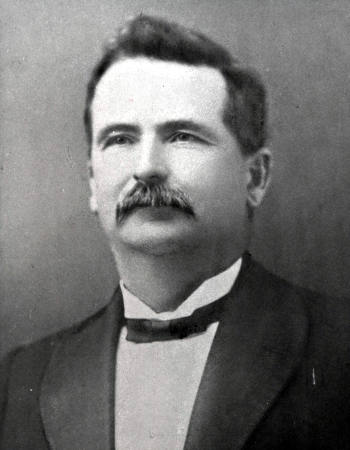
J L Smith, President of Shire of Moorabbin (Born 1st January 1860 – Died 20th November 1932).
John Logan Smith, (known simply as JLS throughout his life), was the eldest child of Irish immigrants, James, (Jim), and Marianne Smith, (nee Logan). He was born at his parent’s home in Point Nepean Road, close to the site of the ‘Toll Gates’, near Dendy Street. JLS attended John Webb’s private school, in Hawthorn Road. Brighton. He had two younger brothers, James Patrick, and Francis Alexander and lastly, a sister, Elizabeth. In JLS’ childhood the area known as East Brighton, later Bentleigh, had many orchards, planted by the early settlers. JLS recalled that in those days the fruit was free of all pests, (including the Apple and Pear Board!). However, over the next decades, market gardening soon replaced the orchards and became the chief primary industry of the area.
Early on, entertainment was simple. A racecourse occupied vacant land, now known as the Bentleigh Recreation Reserve. Its turf saw many exciting finishes between local favourites, and those from neighbouring districts in the sporting fixtures of those early days. JLS recalled that among the spectators, the aboriginal known as Jimmy, in tall silk hat and dressing gown, and his partner Nancy, in less picturesque attire, were often to be seen. They were always accompanied by hordes of hungry and half-starved dogs.
In the 1870s JLS’ parents were running a small hotel on the corner of Centre and Jasper Roads in Bentleigh, then known as East Brighton. At that time there were actually two hotels located on opposite corners. They were called the Hit or Miss, (most appropriate for the busy intersection it is today), and the Live and Let Live thought to be the hotel owned by Jim and Marianne. Both were destroyed by fire early on. When Jim and Marianne’s little timber hotel caught fire, JLS recalled his father, Jim, madly throwing a very few precious possessions into a small tin trunk. Then, according to family history, Marianne sat on the trunk, with her children around her, and watched the hotel burn to the ground.
In about 1875, JLS’ father, Jim, had selected land at Congupna, near Shepparton. Following the loss of the hotel and their possessions, the family left East Brighton/Bentleigh to work their selection. At this time JLS was about 15 years of age, and had finished his schooling. He had grown into a stocky, dark haired young man. Over the next years, JLS helped his father to clear their selection, and plant and harvest the first wheat crop grown there.
But at Congupna, JLS missed all the friends and relatives of his early teenage years so his father, Jim, agreed that his son should return to East Brighton. JLS left to start his new life there. On his return to East Brighton, JLS initially rented, then purchased, a market garden and mixed farm, in Tucker Road, East Bentleigh, from his uncle Mr Joseph Marquis. In September. 1884 at 24 years of age, JLS married Mary Ann Allnutt, (known as ‘Minnie’ to her family and friends). Mary Anne was a devout Methodist.
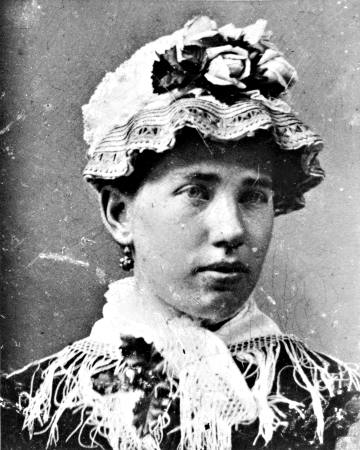
Mary Ann Allnutt, c1877. Courtesy Helen Stanley.
Mary Ann’s parents were the pioneers, Joseph and Matilda Allnutt. The couple had arrived aboard the ship Grand Trianon in May 1857. They were ‘Assisted Immigrants’. Mary Ann was born in Patterson Road where her parents lived in a wattle and daub hut, with earthen floor and butter muslin over the windows. Initially the family drew their water from a swamp nearby. Later they lived in Brady Road. Her father later kept the railway gates in Patterson Road., before the present bridge was built there. Mary Ann initially attended St Stephen’s Common School in Tucker Road paying nine pence per week. She was amongst the first class of school children to walk over the paddocks to the new little State School built in Centre Road, East Bentleigh.
Mary Ann, a dressmaker, had been reluctant to marry, however, her younger sister, Elsie, had already married JLS’ brother, Frank (Francis), Smith, and she was afraid she would lose JLS to someone else if she didn’t.
JLS and Mary Ann’s first years of marriage were far from easy. In 1885 Mary Ann had their first child Constance (Connie) who died in infancy that same year. Mary Ann herself was unwell at that time. Sadly, Mary Ann recalled to her family that she felt Connie had died, because of her own poor health, she had not been able to care for Connie sufficiently. At this time, their market garden in Tucker Road, East Bentleigh, was viable and the couple were making a reasonable living. However, shortly after, their fortunes would soon to take a turn for the worse.
In June 1888 land prices were booming in Victoria, fortunes were being made in land sales. Mary Ann and JLS had had a further two healthy daughters; Jessie Lillian in 1886, Eva Annie in 1888, and were soon to have a son, Archie Oswald in 1889. The future looked ‘rosie’!
At this time, JLS sold his market garden in Tucker Road, East Bentleigh, to a land speculator for what was considered a fortune. JLS was then considered rich enough, at 28 years of age, to retire on £1000. However, the land speculator argued, that, as JLS didn’t really need all the money at once, he’d pay in instalments and JLS could still live, in retirement, on the interest. JLS agreed! At this time JLS arranged to purchase two little cottages in Selwyn Street, Brighton from his deceased father’s estate.
Alas, not long after, the financial world crashed with banks closing their doors and land speculators and financiers being declared bankrupt. The unfortunate land speculator who contracted to purchased JLS property shot himself, an all too frequent happening at this time. This meant that JLS received no payment. He had the Tucker Road property back on his hands, and he and his young family were virtually destitute – still owing payment for the Selwyn Street properties. JLS felt it was immoral that the land speculator had taken this way out. JLS and his wife struggled over the next depression years to feed their growing family and repay their debts. To JLS’ relief, at a later date, Joseph Marquis offered to buy back the Tucker Rd. property, which he did.
In the late 1890’s JLS had accumulated rather a lot of grey-box firewood. It was sent down to him from his sister, Elizabeth and her husband, (Fred Ford), who lived at Katandra for JLS’ fire. Mary Ann told JLS that, as they had too much wood for their own use, he should sell some of it. As simply as this, in 1890, a family business began to develop that would prosper and last for over 70 years.
In the late 1890’s three more sons were born to JLS and Mary Ann, namely– Cyril Victor, (Vic), in 1896, Albert Allnutt, (Tom), in 1898 and finally Harry Redvers in 1899.
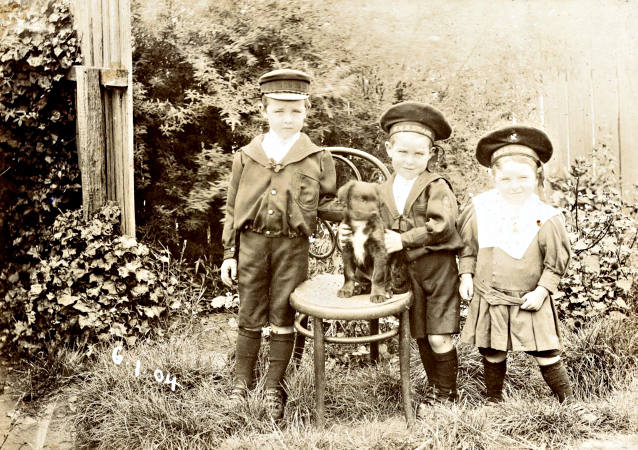
Children of J L Smith, Vic, Tom (Albert) and Harry Smith with pup Brassey. Courtesy Helen Stanley.
JLS initially rented a cottage, Law Muir Den, and a shed in Centre Road, Bentleigh from Mr Box. He later purchased both. JLS commenced business as a wood merchant, sawing logs of wood into shorter lengths by means of a ‘horse-works’, one horse power and selling them. This shed soon had a veranda and other additions. As the business prospered it was extended to be ‘fuel and fodder’ trade, and later a chaff-cutting mill was installed. Farmers from places as distant as Carrum bought their loads of hay to be cut into chaff. The power at this time was a ten horse power steam engine. My father, Harry Redvers Smith, recalled as a boy, that part of the preparation for oats, prior to crushing, was to soften them using steam. Passers-by would always remark on the ‘rather strong smell of porridge’ wafting from the old grain store!
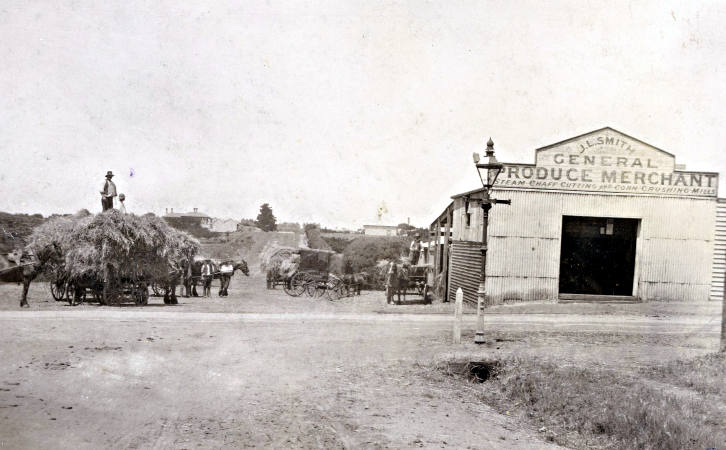
Store of L J Smith, General Produce Merchant, Centre Road Bentleigh. Courtesy Helen Stanley.
Always inventive, JLS put the steam engine to other ‘domestic’ use, as well. JLS laid a pipe from the steam engine the short distance across the yard to the adjacent little Law Muir Den where they lived. Despite being very noisy, the steam effectively heated the family’s water for washing and bathing. ‘Running hot water’ was quite a luxury in those days! Later this steam engine was superseded by an oil engine, (15 horse power), and a grain crushing plant was added. With the extension of the electricity mains to Bentleigh in 1916 an electric motor, 20 Horse Power, was installed at the grain store.
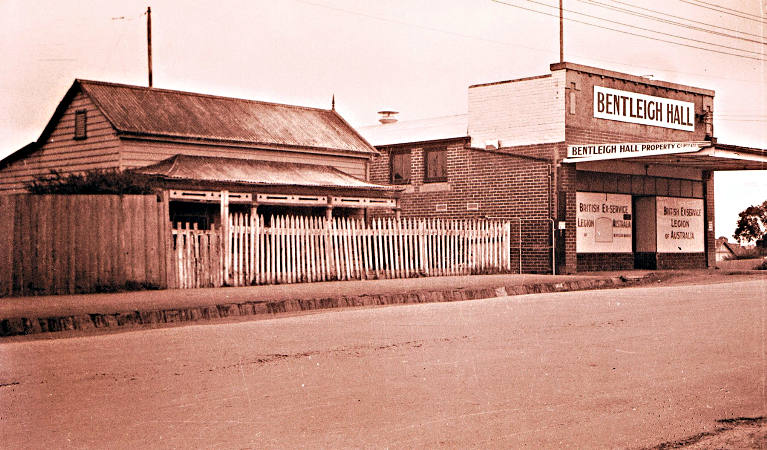
Law Muir Den. Courtesy Helen Stanley.
The early 1900’s was a time of prosperity for JLS and Mary Ann. The hay and grain store was very busy as Bentleigh and surrounding district developed. JLS employed six to eight men. It was not unusual to have four or five carts being either loaded or unloaded at one time.
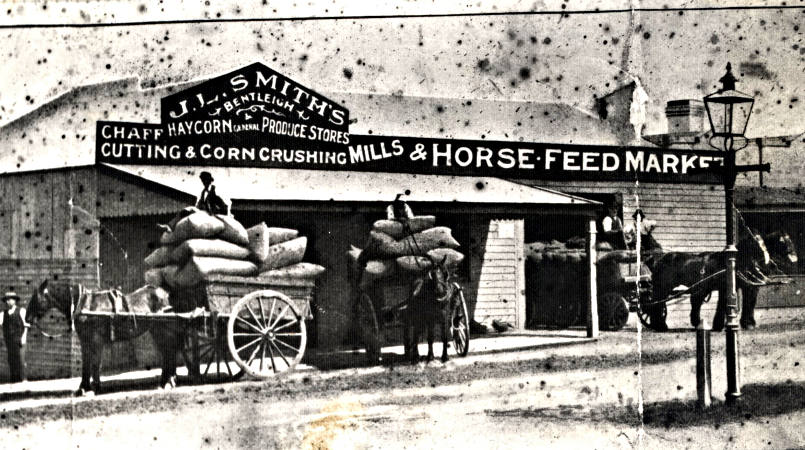
L J Smith’s Hay, Corn and Produce Store, c1910. Courtesy Helen Stanley.
In 1904, Harry, JLS’ youngest child, (my father), started school at East Bentleigh State School when he was only about 3 1/2yrs of age, but wanted to go to school. Dad recalled that when he started school all the girls flocked around him, and lifted him up. They often carried him around the school. He put this down to the fact of looking rather ‘babyish’, and rather podgy too, with quite fair, long curls. After the fashion of the day he wore a tunic-style ‘dress’ with a large collar and belt, covering a pair of shorts, rather than trousers. At that time the youngest school children sat up in a high gallery, around the class, probably so they could see the teacher. Any misbehaving students were punished by being stuck under the gallery, behind a closed wall.
In the December of 1905 JLS paid eleven shillings for the year’s rent on the first telephone in Bentleigh to be installed at his grain store. It was Telephone Number 282, Brighton. Whilst the telephone was a great boon for the business, it also had a ‘down-side’. Luckily, JLS had a fairly large family, as people would ring from far and wide requesting ‘messages’ to be passed onto others, living in the surrounding districts. This necessitated someone, usually a family member, being despatched to far-flung places to relay the message.
In 1909 JLS patented a Safety Shield for Chaff Cutters, a safety device for the feed of chaff-cutters. In those days it was not unusual for a worker to lose an arm, or be otherwise maimed, when ‘feeding’ the chaff cutting machine. JLS proudly entered this Patented Smith’s Safety Shield in the Royal Melbourne Agricultural Show. To his dismay, someone else had beaten him to it, with a very similar concept, and won the prize. JLS suspected his Safety Shield’s design had been copied, and he’d been ‘dudded’. Never the less, he did go on to sell a few Smith’s Safety Shields, and he certainly used it successfully on his own chaff-cutting machine.
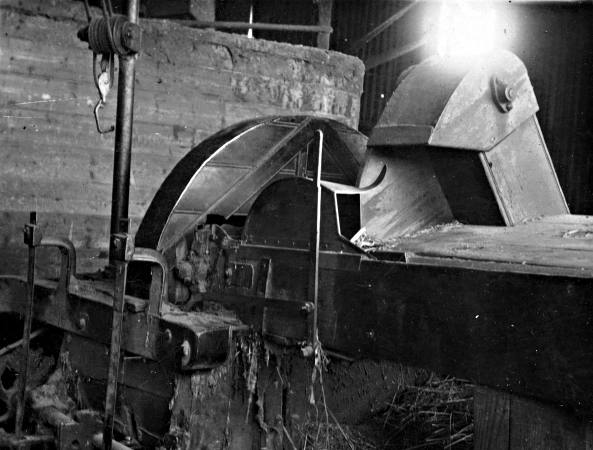
Chaff Cutter safety device. Courtesy Helen Stanley.
The advent of the train line to Bentleigh and beyond, pushed through parliament by Tommy Bent MP, made a huge difference to Bentleigh. There were deliveries to and from the siding at the station. Goods were sent down so much more easily from the country to JLS’ store, or onto other destinations. JLS continued to prosper.
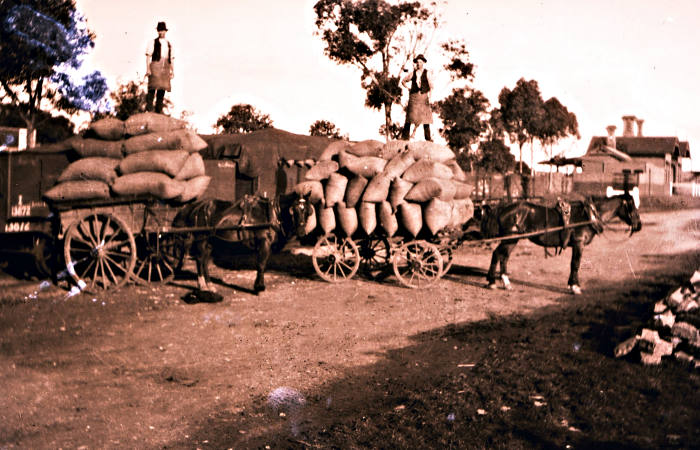
Loading wagons at the Bentleigh railway siding. Photography Victor C Smith.
In 1909, following Tommy Bent’s “lamentable death”, some forty-six long-standing community members, including Messrs. Box, C. E. Burgess, the Simmonds’, George and William Ward, and other well-known local identities nominated JLS for the vacancy of Councillor in the Shire of Moorabbin. Voting was not compulsory at that time. Just to be sure, JLS, always an entrepreneur, hired a chauffeur-driven car to take any community members, who wished to vote for him, to the voting booth. As cars were still quite a novelty in those days, enough voters took advantage of the ‘free ride offer’ to ensure JLS’ election to council.
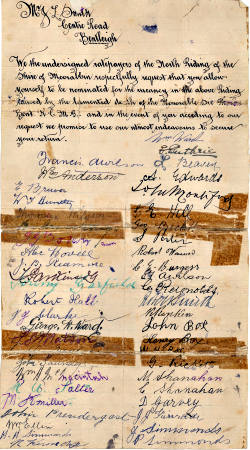
Petition from local residents requesting J L Smith to stand for council. Courtesy Helen Stanley.
During the first decade of the twentieth century one of JLS’ sons, Vic, took a great interest in photography which was still in its ‘infancy’. Vic, who remained a bachelor, took many wonderful photographs of Bentleigh, and of its inhabitants in those early days, and left a wonderful legacy. Also at this time, Jesse and Eva, JLS’ daughters, opened a little shoe shop in some rooms at the side their father’s store, where they sold Marshall Shoes. JLS encouraged the girls to be independent. Both girls also taught weekly at the Methodist Mission to Chinese market gardeners in Lydia Street. The Annual Free Tea Meetings, given by the Chinese students to their teachers and friends, were a lavish and memorable feature of those halcyon days. The Mission continued for many years.
In 1914 there was a very severe drought. As a stock feed merchant JLS was in a desperate situation. Harry Smith, JLS’ son recalled, “the chaff that dad got was dreadful stuff, black raked over hay off the dirt, selling at one pound a bag, although it normally only cost five shillings.”. In addition, to get by, JLS sold many ‘funny’ grains. Where wheat crops and corn crops had failed he bought the ruined crop, and milled it for stock feed. He also sold linseed, and a product called “Jap Bran”, a stock feed probably imported from Japan.
Also in 1914 JLS was elected president of Moorabbin Shire. During that year, JLS, with a group of like-minded residents, subscribed to a trust to build the Bentleigh Recreation Reserve where “cricket, football, lawn tennis and concerts and other entertainments could be held.” Although the area had always been used informally, it was now purchased from William McArthur for six hundred pounds. Over time a grandstand was built. The area remains for the community in 2004.
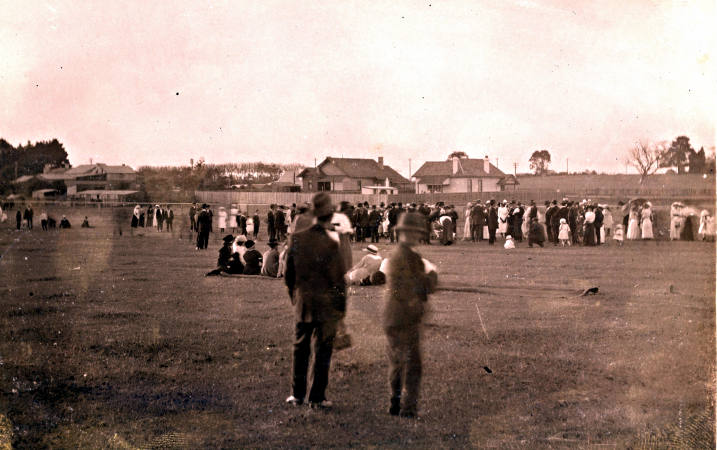
Bentleigh Recreation Reserve. Photographer Victor C Smith.
On the August 4, 1914 on a beautiful fine sunny day the first shot was fired at Port Phillip Heads across the bow of the German ship the Pfalz. World War One which lasted until 1918, had commenced. Both JLS and Mary Ann were heavily involved with local auxiliaries, the Red Cross and in general with the war effort. Vic, their son, went to the war as a Signaller. Vic’s cousin, Ray Smith, (Frank Smith’s son, JLS’ brother), also joined up, went overseas, and sadly died of dysentery due to the terrible conditions in the trenches. It was a blow to the close-knit family. Ray’s name is listed on the World War One Memoriam located in the Bentleigh Reserve.
JLS’ youngest son, Harry, also “joined up” in 1918. (He was just 18yrs old). Harry joined the Lighthorse Brigade. The most important criteria for this Brigade, was, that you could provide your OWN horse, as horses were in “scarce supply”. Harry trained at “Broady”, (Broadmeadow), barracks. He recalled the Brigade trained on foot, because not everyone had horses, and complete uniforms were scarce. Boots were ill-fitting. The war finished before he could be sent overseas. (However, Harry did ride with the Brigade behind Sir John Monash’s funeral).
In 1923, JLS and Mary Ann also moved into Walda, a rather pretty, weatherboard home, located in Centre Road., where the Bentleigh RSL stands today. Mary Ann always had help in the house. Various relatives, usually from the country, looking for work, were always on hand. My mother recalled, (Mary Ann’s daughter-in-law), that if you were ever asked to tea, it wasn’t necessarily a treat, as you would be expected to prepare the vegies and help cook the meal. The household “help”, being relatives, always took the opportunity to sit down and join in!
In 1926 advancing with the growth of motor transport JLS built a small, square, “no frills” garage on the opposite corner to the original Hay and Grain Store. JLS, always astute, was looking to the future and planning ahead for the burgeoning car era. He rented this garage to George Piper and Mr Bertram for two pounds weekly. However, when Mr Garfield, (a wealthy market gardener), opened a big garage on the corner directly opposite, Piper and Bertram left JLS to manage this new one. They left JLS’ garage empty until the lease ran out.
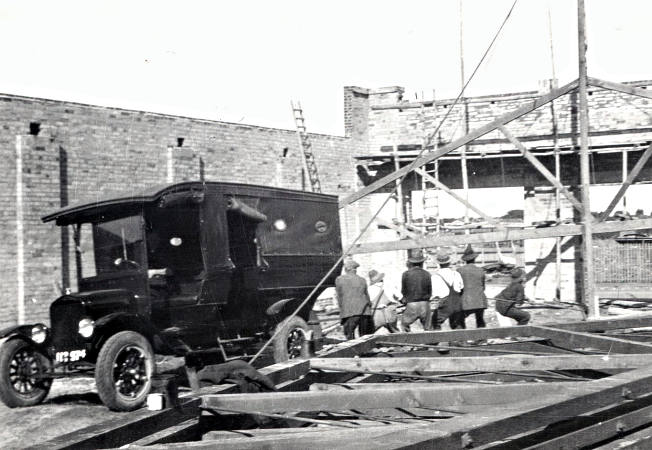
Garage being built for Mr Garfield in Centre Road Bentleigh. Photographer Victor C Smith.
Never defeated, JLS then decided to manage the garage himself with the help of his sons. He employed a good mechanic and established a very successful garage business. Extensive alterations were made to accommodate a furniture storage facility and motor repair shop. A Public Weighbridge was also installed. The original Smith’s Hay and Grain store, opposite, also managed by the family, continued trading until 1930.
On the morning of the November 20, 1932, a man whose car had broken down not far away, approached JLS whose garage was the only one open so early in the morning. He asked JLS’ assistance to push his car into the garage for repairs. That evening JLS suffered a heart attack and, though the doctor came, there was little he could do. Word spread quickly that JLS was dying, and the Bentleigh band, who were practising in the Recreation Reserve located at the rear of Walda, broke into the hymn “Abide With Me”. John Logan Smith is buried in the Pioneer Section of the Cheltenham Cemetery.
After nearly 50 years, on May 4, 1935, land in Centre Road., (today’s shopping strip) and in Jasper Road., that JLS had purchased over the years in Bentleigh, was sub-divided and “Smith’s Estate” was auctioned.
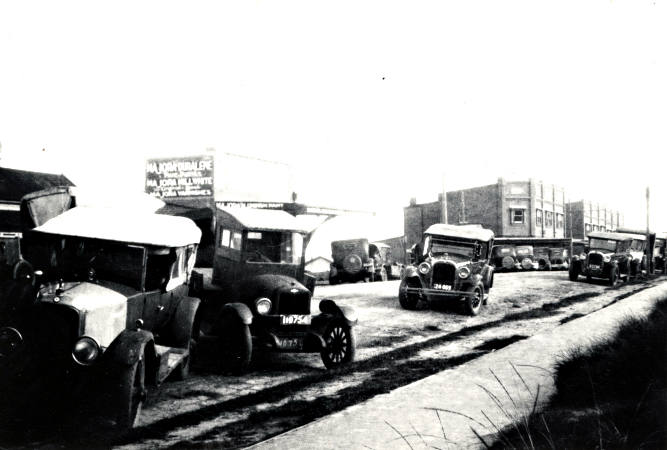
Cars in Centre Road Bentleigh during sale of Smith’s Estate. Photographer Victor C Smith.
On the September 16, 1949 Mary Ann Smith passed away and was buried beside her husband in the Cheltenham Cemetery
